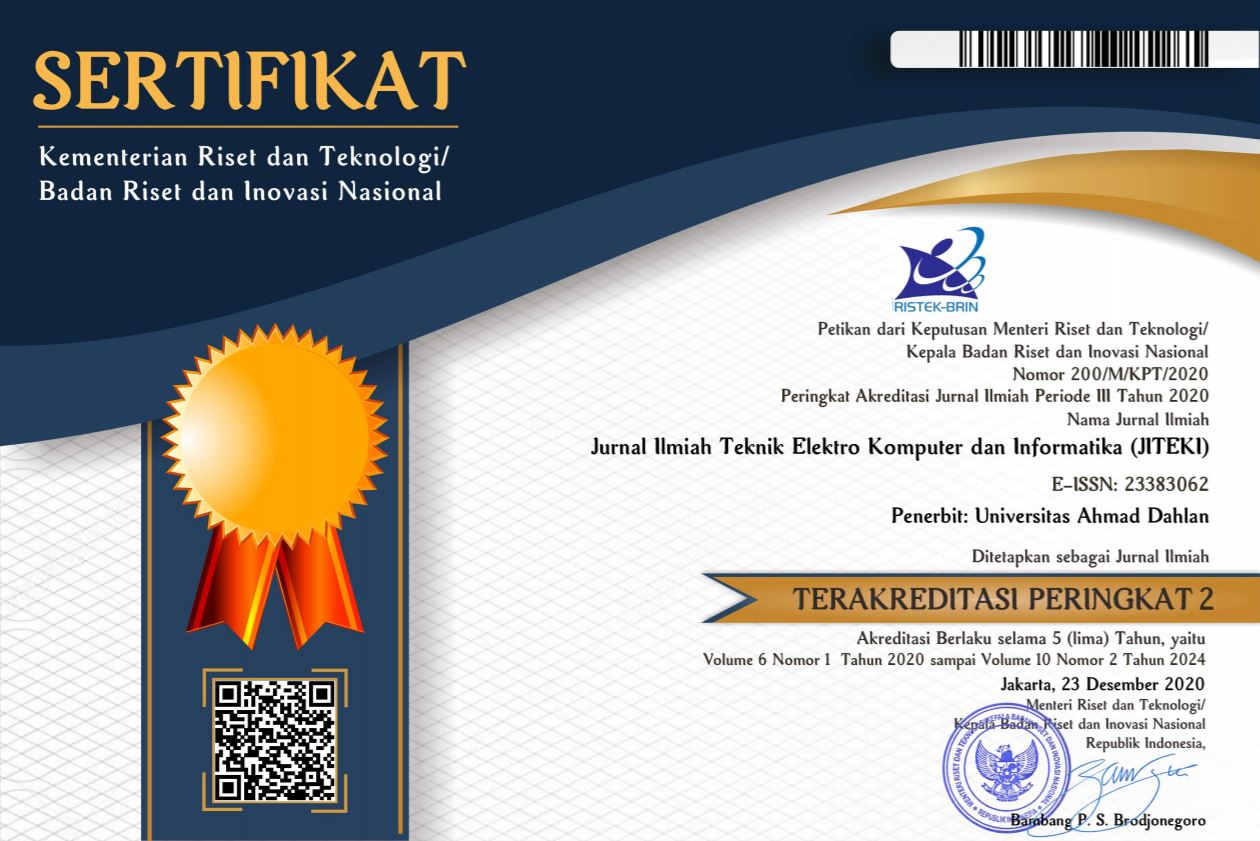Adapted Generalized Unsharp Masking Algorithm for Sharpness Improvement of Scanning Electron Microscopy Images
Abstract
Keywords
Full Text:
PDFReferences
M. Ali et al., “Pollen micromorphology of eastern Chinese Polygonatum and its role in taxonomy by using scanning electron microscopy,” Microscopy Research and Technique, vol. 84, no. 7, pp. 1451–1461, 2021, https://doi.org/10.1002/jemt.23701.
E. Pach and A. Verdaguer, “Studying ice with environmental scanning electron microscopy,” Molecules, vol. 27, no. 1, p. 258, 2021, https://doi.org/10.3390/molecules27010258.
M. A. Sutton, N. Li, D. C. Joy, A. P. Reynolds, and X. Li, “Scanning electron microscopy for quantitative small and large deformation measurements part I: SEM imaging at magnifications from 200 to 10,000,” Experimental Mechanics, vol. 47, no. 6, pp. 775–787, 2007, https://doi.org/10.1007/s11340-007-9042-z.
A. E. Vladár, M. T. Postek, and M. P. Davidson, “Image sharpness measurement in scanning electron microscopy-part II,” Scanning, vol. 20, no. 1, pp. 24–34, 2006, https://doi.org/10.1002/sca.1998.4950200104.
Z. Al-Ameen, “An improved contrast equalization technique for contrast enhancement in scanning electron microscopy images,” Microscopy Research and Technique, vol. 81, no. 10, pp. 1132–1142, 2018, https://doi.org/10.1002/jemt.23100.
K. Ohta, S. Sadayama, A. Togo, R. Higashi, R. Tanoue, and K.-I. Nakamura, “Beam deceleration for block-face scanning electron microscopy of embedded biological tissue,” Micron, vol. 43, no. 5, pp. 612–620, 2012, https://doi.org/10.1016/j.micron.2011.11.001.
M. E. Rudnaya, R. M. Mattheij, and J. M. L. Maubach, “Evaluating sharpness functions for automated scanning electron microscopy,” Journal of Microscopy, vol. 240, no. 1, pp. 38–49, 2010, https://doi.org/10.1111/j.1365-2818.2010.03383.x.
M. R. Banham and A. K. Katsaggelos, “Digital image restoration,” IEEE Signal Processing Magazine, vol. 14, no. 2, pp. 24–41, 1997, https://doi.org/10.1109/79.581363.
Q. Huang, “An image sharpness enhancement algorithm based on Green function,” Traitement Du Signal, vol. 38, no. 2, pp. 513–519, 2021, https://doi.org/10.18280/ts.380231.
L. Li, D. Wu, J. Wu, H. Li, W. Lin, and A. C. Kot, “Image sharpness assessment by sparse representation,” IEEE Transactions on Multimedia, vol. 18, no. 6, pp. 1085–1097, 2016, https://doi.org/10.1109/TMM.2016.2545398.
J. P. Allebach, “Optimal unsharp mask for image sharpening and noise removal,” Journal of Electronic Imaging, vol. 14, no. 2, p. 023005, 2005, https://doi.org/10.1117/12.538366.
M. S. Millán and E. Valencia, “Color image sharpening inspired by human vision models,” Applied Optics, vol. 45, no. 29, pp. 7684–7697, 2006, https://doi.org/10.1364/AO.45.007684.
Z. Gui and Y. Liu, “An image sharpening algorithm based on fuzzy logic,” Optik, vol. 122, no. 8, pp. 697–702, 2011, https://doi.org/10.1016/j.ijleo.2010.05.010.
S. Skoneczny, “Nonlinear image sharpening in the HSV color space,” Electrotechnical Review, vol. 88, no. 2, pp. 140–44, 2012. http://pe.org.pl/articles/2012/2/39.pdf.
C. C. Yang, “Finest image sharpening by use of the modified mask filter dealing with highest spatial frequencies,” Optik, vol. 125, no. 8, pp. 1942–1944, 2014, https://doi.org/10.1016/j.ijleo.2013.09.070.
C. C. Pham and J. W. Jeon, “Efficient image sharpening and denoising using adaptive guided image filtering,” IET Image Processing, vol. 9, no. 1, pp. 71–79, 2015, https://doi.org/10.1049/iet-ipr.2013.0563.
P. Zafeiridis, N. Papamarkos, S. Goumas, and I. Seimenis, “A new sharpening technique for medical images using wavelets and image fusion,” Journal of Engineering Science & Technology Review, vol. 2016, no. 3, pp. 187–200, 2016, https://doi.org/10.25103/jestr.093.27.
D. Zerbino, “Improving image sharpness by surface recognition,” Econtechmod: Scientific Journal, vol. 4, no. 8, pp. 39–44, 2019, https://yadda.icm.edu.pl/baztech/element/bwmeta1.element.baztech-37477bd3-c190-4442-9520-0fd28b862646.
K. Luo, M. Lin, P. Wang, S. Zhou, D. Yin, and H. Zhang, “Improved ORB-SLAM2 algorithm based on information entropy and image sharpening adjustment,” Mathematical Problems in Engineering, vol. 2020, pp. 1–13, 2020, https://doi.org/10.1155/2020/4724310.
G. Deng, “A generalized unsharp masking algorithm,” IEEE Transactions on Image Processing, vol. 20, no. 5, pp. 1249–1261, 2011, https://doi.org/10.1109/TIP.2010.2092441.
S. M. Pizer et al., “Adaptive histogram equalization and its variations,” Computer Vision, Graphics, and Image Processing, vol. 39, no. 3, pp. 355–368, 1987, https://doi.org/10.1016/S0734-189X(87)80186-X.
S. M. Smith and J. M. Brady, “SUSAN–a new approach to low level image processing,” International Journal of Computer Vision, vol. 23, no. 1, pp. 45–78, 1997, https://doi.org/10.1023/A:1007963824710.
C. Tomasi and R. Manduchi, “Bilateral filtering for gray and color images,” in Sixth International Conference on Computer Vision (pp. 839-846), 1998, https://doi.org/10.1109/ICCV.1998.710815.
S. Bettahar and A. B. Stambouli, “Shock filter coupled to curvature diffusion for image denoising and sharpening,” Image and Vision Computing, vol. 26, no. 11, pp. 1481–1489, 2008, https://doi.org/10.1016/j.imavis.2008.02.010.
Z. Al-Ameen, G. Sulong, and M. G. M. Johar, “Fast deblurring method for computed tomography medical images using a novel kernels set,” International Journal of Bio-Science and Bio-Technology, vol. 4, no. 3, pp. 9–19, 2012, https://gvpress.com/journals/IJBSBT/vol4_no3/2.pdf.
Z. Al-Ameen, S. Al-Ameen, and A. Al-Othman, “Improving the sharpness of digital images using a modified Laplacian sharpening technique,” IPTEK The Journal for Technology and Science, vol. 29, no. 2, p. 44, 2019, https://doi.org/10.12962/j20882033.v29i2.3356.
D. Ngo, S. Lee, and B. Kang, “Nonlinear unsharp masking algorithm,” in 2020 International Conference on Electronics, Information, and Communication (ICEIC), 2020, https://doi.org/10.1109/ICEIC49074.2020.9051376.
F. Crete, T. Dolmiere, P. Ladret, and M. Nicolas, “The blur effect: perception and estimation with a new no-reference perceptual blur metric,” in Human Vision and Electronic Imaging XII, 2007, https://doi.org/10.1117/12.702790.
K. Bahrami and A. C. Kot, “A fast approach for no-reference image sharpness assessment based on maximum local variation,” IEEE Signal Processing Letters, vol. 21, no. 6, pp. 751–755, 2014, https://doi.org/10.1109/LSP.2014.2314487.
Y. Ominami, K. Nakahira, S. Kawanishi, and S. Ito, “Reduction of electron scattering image blur for atmospheric scanning electron microscopy,” Microscopy and Microanalysis, vol. 21, no. S3, pp. 241–242, 2015, https://doi.org/10.1017/S1431927615002007.
L. Zhang, M. H. Garming, J. P. Hoogenboom, and P. Kruit, “Beam displacement and blur caused by fast electron beam deflection,” Ultramicroscopy, vol. 211, p. 112925, 2020, https://doi.org/10.1016/j.ultramic.2019.112925.
J. Na, G. Kim, S. H. Kang, S. J. Kim, and S. Lee, “Deep learning-based discriminative refocusing of scanning electron microscopy images for materials science,” Acta Materialia, vol. 214, p. 116987, 2021, https://doi.org/10.1016/j.actamat.2021.116987.
H. Morishita, T. Ohshima, M. Kuwahara, Y. Ose, and T. Agemura, “Resolution improvement of low-voltage scanning electron microscope by bright and monochromatic electron gun using negative electron affinity photocathode,” Journal of Applied Physics, vol. 127, no. 16, p. 164902, 2020, https://doi.org/10.1063/5.0005714.
M. Enyama, M. Sakakibara, S. Tanimoto, and H. Ohta, “Optical system for a multiple-beam scanning electron microscope,” Journal of Vacuum Science & Technology B, vol. 32, no. 5, p. 051801, 2014, https://doi.org/10.1116/1.4891961.
J. Na, G. Kim, S.-H. Kang, S.-J. Kim, and S. Lee, “Deep learning-based discriminative refocusing of scanning electron microscopy images for materials science,” Acta Materialia, vol. 214, no. 116987, p. 116987, 2021, https://doi.org/10.1016/j.actamat.2021.116987.
R. Laws, D. H. Steel, and N. Rajan, “Research techniques made simple: Volume scanning electron microscopy,” Journal of Investigative Dermatology, vol. 142, no. 2, pp. 265-271.e1, 2022, https://doi.org/10.1016/j.jid.2021.10.020.
K. L. House, L. Pan, D. M. O’Carroll, and S. Xu, “Applications of scanning electron microscopy and focused ion beam milling in dental research,” European Journal of Oral Sciences, vol. 130, no. 2, p. e12853, 2022, https://doi.org/10.1111/eos.12853.
R. Ali, K. El-Boubbou, and M. Boudjelal, “An easy, fast and inexpensive method of preparing a biological specimen for scanning electron microscopy (SEM),” MethodsX, vol. 8, no. 101521, p. 101521, 2021, https://doi.org/10.1016/j.mex.2021.101521.
T. D. Pham, “Kriging-weighted laplacian kernels for grayscale image sharpening,” IEEE Access, vol. 10, pp. 57094–57106, 2022, https://doi.org/10.1109/ACCESS.2022.3178607.
R. Mankar, C. C. Gajjela, F. F. Shahraki, S. Prasad, D. Mayerich, and R. Reddy, “Multi-modal image sharpening in fourier transform infrared (FTIR) microscopy,” Analyst, vol. 146, no. 15, pp. 4822–4834, 2021, https://doi.org/10.1039/D1AN00103E.
DOI: http://dx.doi.org/10.26555/jiteki.v8i3.24179
Refbacks
- There are currently no refbacks.
Copyright (c) 2022 Zaid Alsaygh, Zohair Al-Ameen

This work is licensed under a Creative Commons Attribution-ShareAlike 4.0 International License.
| About the Journal | Journal Policies | Author | Information |
Organized by Electrical Engineering Department - Universitas Ahmad Dahlan
Published by Universitas Ahmad Dahlan
Website: http://journal.uad.ac.id/index.php/jiteki
Email 1: jiteki@ee.uad.ac.id



